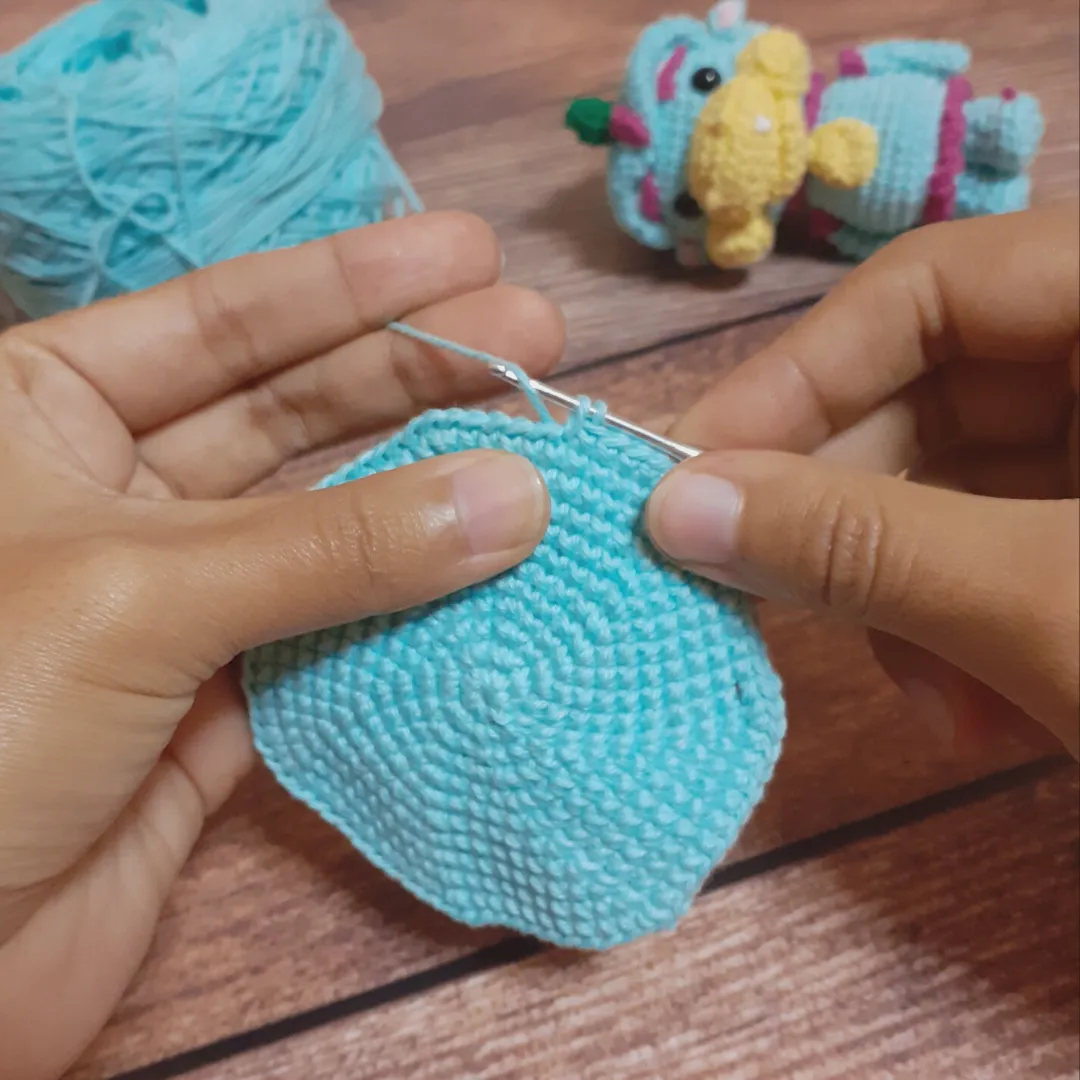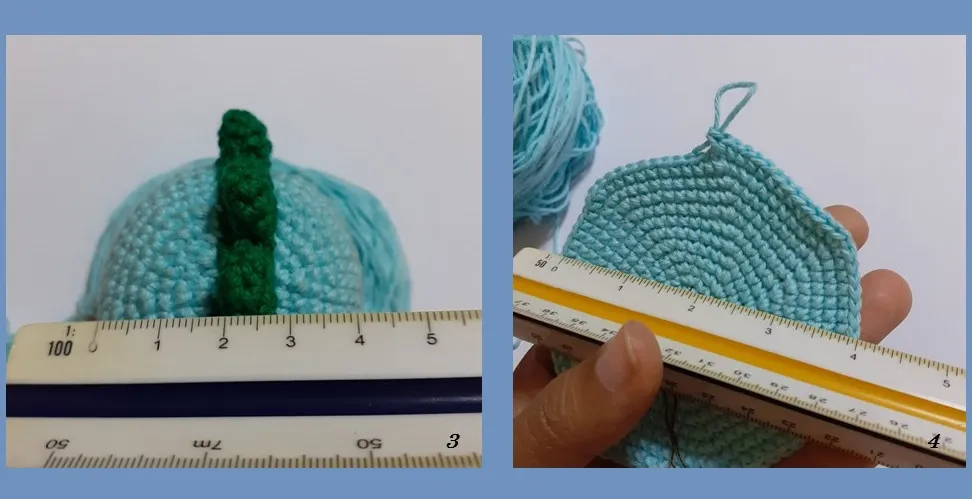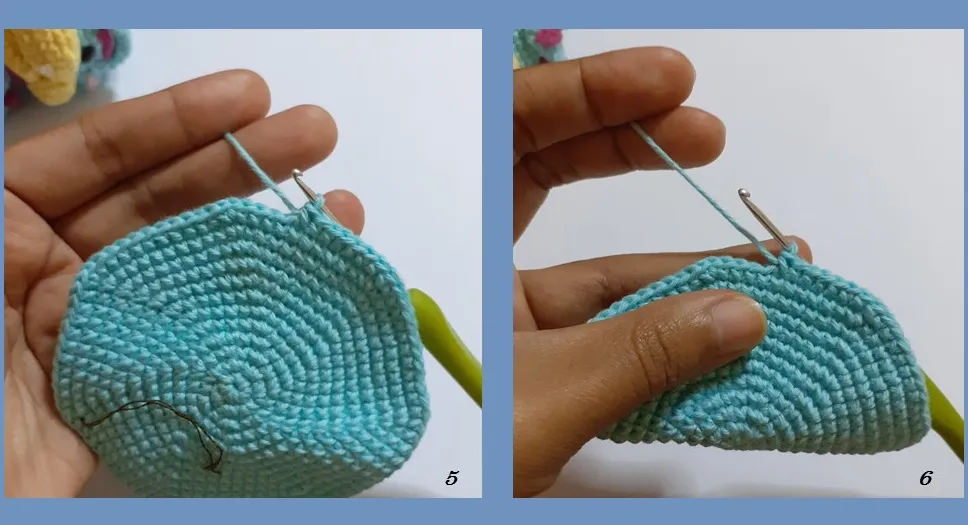
¡Hola, espero la estén pasando bien!
Hi, I hope you are having a good time!
Esta publicación será algo diferente. Hoy les traigo 5 atajos o truquillos para el tejido a crochet, sobre todo en amigurumis aunque también pueden aplicarse al tejido en general.
This post will be a bit different. Today I bring you 5 shortcuts or tricks for crochet knitting, especially for amigurumis although they can also be applied to knitting in general.
Tejidos en espiral / spiral weaving:

- Para los tejidos en espiral, les recomiendo utilizar un pedazo de hilo (de coser o bordar) de color contrastante al tejido. Esto remplazaría al “marcador de vueltas”. Tiene la ventaja de evitar estar quitando y poniendo a cada rato, solo te guiarás por la línea recta que irá encima del hilo (fig. 1)
For spiral weaves, I recommend using a piece of thread (sewing or embroidery thread) in a contrasting colour to the weave. This would replace the "lap marker". It has the advantage of avoiding the need to be removing and inserting every now and then, you will only be guided by the straight line that will go on top of the thread (fig. 1).
- Otro truco es cuando se sigue una secuencia monótona. Por ejemplo: (1punto, 1 aumento) x 6; (2puntos, 1 aumento) x 6; (3puntos, 1 aumento) x 6 y así sucesivamente. En lugar de estar contando en cada ronda los números de puntos deseados para tejer los aumentos, cada aumento de la fila siguiente, se tejerá en el lado izquierdo del aumento de la fila anterior (flecha y "v" de la fig. 1).
Another trick is when a monotonous sequence is followed. For example: (1stitch, 1 increase) x 6; (2stitches, 1 increase) x 6; (3stitches, 1 increase) x 6 and so on. Instead of counting the desired number of stitches in each round to knit the increases, each increase of the next row will be knitted on the left side of the increase of the previous row (arrow and "v" in fig. 1).
- Este truco quizá ya es conocido por aquí. Para evitar que la madeja esté rodando por todos lados, trabajar con el hilo del centro, de esta manera se enredará menos (fig. 2).
This trick is probably already known here. To avoid the skein rolling all over the place, work with the yarn in the middle, this way it will be less tangled (fig. 2).
Aumento del tamaño de un amigurumi / Increasing the size of an amigurumi :

La manera mas sencilla de tejer un amigurumi más grande es utilizar un hilo o lana más gruesa. La más complicada, es utilizando un escalímetro. Este, es una regla triangular y se caracteriza por llevar diferentes escalas. Es más utilizado en la elaboración de planos. Digo que es algo complicado porque se tiene que rediseñar el patrón original de 11cm a 20cm de altura. Para esto con la ayuda del escalímetro, busqué una escala que coincida con la medida de los 20cm. La cabeza del amigurumi mide 4cm, entonces en esta escala también medirá 4cm (fig. 3 y 4).
The easiest way to knit a larger amigurumi is to use a thicker yarn or wool. The most complicated way is to use a scalimeter. This is a triangular ruler and is characterised by its different scales. It is most commonly used in drawing plans. I say it is somewhat complicated because you have to redesign the original pattern from 11cm to 20cm in height. For this, with the help of the scalimeter, I looked for a scale that matches the 20cm measurement. The amigurumi head measures 4cm, so in this scale it will also measure 4cm (fig. 3 and 4).
Tejidos rectos (sin disminuciones ni aumentos)/ Straight weaves (no decreases or increases)

Colocar el pedazo de hilo de bordar en el primer punto del tejido recto, esto marcará el inicio y sabrás cuántas hileras rectas estás tejiendo (fig. 5).
Otro truco para avanzar tejer más rápido es doblar el tejido por la mitad, como si fuese una empanada. Esto le dará firmeza y utilizarás menos fuerza en los dedos para mantenerlo tieso (fig. 6).
- Place the piece of embroidery thread in the first stitch of the straight weave, this will mark the beginning and you will know how many straight rows you are weaving (fig. 5).
- Another trick to make your knitting progress faster is to fold the fabric in half, like a patty. This will give it firmness and you will use less finger strength to keep it stiff (fig. 6).
¡Y eso es todo!,
Cuéntame si ¿ya sabías o utilizas algunos de estos trucos?
Tell me if you already know or use any of these tricks?
¡…Hasta la próxima!
See you next time!
Dato curioso: Aproveché a publicar esto ya que el hilo con el que estoy trabajando es de color claro / I took the opportunity to post this as the thread I am working with is light in colour.
►Encuéntranos en:
Creary
